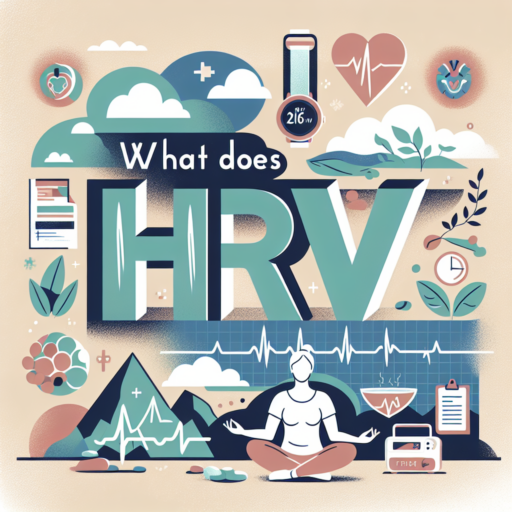Understanding HRV: A Comprehensive Guide
Understanding Heart Rate Variability (HRV) is crucial to comprehending your overall health and wellness. HRV refers to the variation in time between each heartbeat, which is considered a strong indicator of your autonomic nervous system function and an integral part of managing stress, recovery, and resilience. Unlike the constant rhythm that might be expected, a healthy heart actually varies its rate with each beat, reflecting the body’s adaptability and readiness to respond to various situations and stimuli.
HRV and Stress Management
The relationship between HRV and stress is profound, as HRV measures how well your body handles and recovers from stress. Higher HRV is often associated with better physical and mental well-being, indicating a more resilient stress response system. Conversely, lower HRV suggests a potential inability to adequately respond to stress, often signaling overtraining, fatigue, or underlying health issues.
The Importance of Measuring HRV
Measuring your HRV can be a powerful tool in understanding your body’s readiness and capacity to handle physical and emotional stress. It serves as a personal health metric that can guide training, recovery, and lifestyle decisions towards optimal well-being. By monitoring HRV trends over time, individuals can make informed decisions about when to push their limits and when to focus on recovery strategies.
Through a combination of wearable technology and dedicated apps, tracking HRV has become accessible to nearly anyone. This democratization of health data empowers individuals to take charge of their stress management, fitness recovery, and overall health optimization.
The Significance of HRV in Today’s Health Monitoring
Understanding the importance of Heart Rate Variability (HRV) has become pivotal in today’s health monitoring landscape. As a critical indicator of the autonomic nervous system’s functionality, HRV offers insights beyond mere heart rate measurements. This variable showcases the time variation between successive heartbeats, thereby providing a deeper understanding of an individual’s physiological stress and recovery levels. With the rise of wearable technology, monitoring HRV has become more accessible, allowing users to gauge their wellness and fitness levels in real-time.
HRV’s role in stress management and recovery is of particular interest to health enthusiasts and medical professionals alike. It serves as a valuable tool in identifying the body’s response to stress and evaluating overall recovery status. Higher variability often signifies a healthy, responsive autonomic nervous system, indicating better stress management capabilities. Conversely, lower variability may suggest stress, fatigue, or overtraining, necessitating adjustments in lifestyle or training regimens. This capacity to provide immediate feedback makes HRV a cornerstone in personalized health and wellness plans.
Furthermore, advancements in technology have simplified the process of HRV tracking, integrating it into everyday wearables and health apps. This integration has democratized access to vital health data, empowering individuals to take charge of their well-being. By monitoring HRV trends, users can make informed decisions about their physical and mental health activities, optimizing for peak performance and recovery. The significance of HRV in today’s health monitoring cannot be overstated, as it bridges the gap between professional health advice and self-managed care.
Exploring What HRV Stands For and Its Importance
HRV, or Heart Rate Variability, is an often overlooked aspect of heart health that serves as a critical indicator of the autonomic nervous system’s functionality. Unlike the heart rate itself, which measures the number of beats per minute, HRV focuses on the variation in time between each heartbeat. This interval fluctuation is not random; rather, it is a sign of the body’s adaptability and resilience in response to stress, both physiological and psychological.
The significance of HRV lies in its ability to offer insights into our overall well-being and stress levels. Higher HRV values are typically associated with a balanced and responsive autonomic nervous system, indicating better cardiovascular fitness, healthier stress response mechanisms, and a stronger ability to recover from stressors. Conversely, lower HRV values may suggest an overstrained system, potentially signaling poor heart health, higher stress levels, and reduced adaptive capacity.
Understanding your HRV can unlock vital information about your health, guiding you towards lifestyle choices that foster well-being. By monitoring HRV, individuals can gain actionable insights into how their body responds to different stressors and interventions, such as exercise, meditation, and sleep quality. This knowledge empowers people to make informed decisions aimed at enhancing their heart health and overall resilience.
How HRV Works: The Science Behind Heart Rate Variability
Understanding the workings of Heart Rate Variability (HRV) involves diving deep into the complex interplay between our heart and brain. At its core, HRV measures the time variation between each heartbeat, known as interbeat intervals. Unlike heart rate, which looks at the average number of beats per minute, HRV focuses on the minor fluctuations that occur between successive heartbeats. These fluctuations are significant as they reflect the autonomic nervous system’s (ANS) ability to adapt to stress, rest, and recuperation.
The Autonomic Nervous System plays a pivotal role in HRV’s functionality. The ANS is composed of two primary branches: the sympathetic and the parasympathetic nervous systems. The sympathetic system, often described as «fight or flight,» prepares the body for action, increasing heart rate and blood pressure. Conversely, the parasympathetic system, known as «rest and digest,» does the opposite—it calms the body, slowing the heart rate. HRV is a marker of how well our body can balance these two systems in response to internal and external stimuli.
Research in the field of cardiology and neuroscience illustrates that a higher HRV is associated with better cardiovascular fitness, stress resilience, and overall health. Conversely, a lower HRV can indicate stress, fatigue, or underlying health issues. It’s this capacity to dynamically adjust that makes HRV a valuable indicator of a person’s health and wellness.
The Impact of HRV on Fitness and Wellness
Understanding the impact of Heart Rate Variability (HRV) on fitness and wellness is essential for anyone looking to optimize their health and athletic performance. HRV, a measure of the variability in time between each heartbeat, is emerging as a key indicator of autonomic nervous system function and an individual’s ability to handle stress.
For fitness enthusiasts and athletes, monitoring HRV can provide valuable insights into recovery status and training readiness. A higher HRV indicates a strong, resilient cardiovascular system and a higher capacity to tolerate exercise stress. Conversely, a consistently low HRV may signal overtraining, inadequate recovery, or underlying health issues, guiding individuals to adjust their training intensity and rest periods for optimal performance and health outcomes.
In the realm of overall wellness, HRV holds significance beyond the gym. Research suggests that higher HRV levels are associated with reduced stress levels, improved mental health, and a stronger immune response. By understanding how different lifestyle factors—such as sleep, nutrition, and physical activity—affect HRV, individuals can make informed decisions to enhance their mental and physical well-being.
No se han encontrado productos.
Ways to Improve Your HRV for Better Health
Improving your Heart Rate Variability (HRV) is essential for optimizing health and wellness. HRV refers to the variance in time between each heartbeat, which is a critical indicator of your autonomic nervous system’s functionality and overall health. Understanding and enhancing your HRV can lead to better stress management, improved cardiovascular health, and enhanced overall wellbeing. Here are some effective strategies to help elevate your HRV for a more balanced health profile.
Practice Regular Physical Activity
Engaging in consistent physical exercise is one of the most effective ways to improve your HRV. Aerobic exercises, such as jogging, swimming, or cycling, can significantly enhance your heart’s efficiency and resilience. Importantly, it’s not about extreme workouts; even moderate, regular physical activity can lead to substantial improvements in HRV. The key is consistency and enjoyment in your exercise routines to ensure long-term adherence and heart health benefits.
Mindfulness and Stress Reduction Techniques
Stress has a pronounced impact on HRV, with higher stress levels often correlating with lower HRV scores. Incorporating stress reduction techniques such as mindfulness meditation, yoga, or deep-breathing exercises can counteract stress’s negative effects on HRV. These practices not only help in reducing stress but also bolster HRV by promoting relaxation and improving autonomic function. Regularly dedicating time to these practices can create a significant positive shift in your heart’s variability and your ability to manage stress effectively.
Ensuring Quality Sleep
Sleep quality directly influences HRV, making it imperative to optimize your sleep patterns for enhanced heart health. Implementing good sleep hygiene practices—such as maintaining a consistent sleep schedule, creating a restful bedtime routine, and minimizing exposure to screens before bedtime—can improve both sleep quality and HRV. Moreover, understanding and addressing potential sleep disorders or disturbances can further boost HRV. Quality sleep provides the foundation for a healthy HRV, supporting overall vitality and well-being.
HRV Measurement: Tools and Technologies You Need
Understanding your Heart Rate Variability (HRV) can offer profound insights into your overall health, stress levels, and recovery status. With technological advancements, measuring HRV has become more accessible than ever. Below, we delve into the essential tools and technologies designed to provide accurate and detailed HRV measurements.
Wearable Tech for Everyday Tracking
Wearable technology, such as smartwatches and fitness trackers, has revolutionized the way we monitor our health metrics, including HRV. Brands like Fitbit, Garmin, and Apple offer devices that not only track your daily activities but also provide continuous HRV monitoring. These gadgets leverage LED sensors to measure your pulse rate, offering insights into your autonomic nervous system’s activity without intrusive methods.
Smartphone Apps for Immediate Feedback
The ubiquity of smartphones has led to the development of numerous apps designed to measure HRV. These apps often require just a few minutes of your time and the use of your phone’s camera and flashlight. By placing a finger over the camera lens, these applications can detect pulse variations, calculating your HRV scores. This method provides a convenient and efficient way to track your HRV, ensuring you stay informed about your physical condition wherever you are.
Sophisticated Medical Devices for Clinical Accuracy
For individuals seeking more detailed and clinically accurate HRV analysis, medical-grade devices stand out as the gold standard. Utilized in healthcare settings and by professionals, these tools, such as EKG machines, offer the highest precision in HRIR measurements. While more expensive and less accessible than wearable tech and smartphone apps, they present an invaluable resource for athletes, patients with health conditions, or anyone requiring detailed physiological monitoring.
Reading Your HRV Scores: What’s Normal and What’s Not
Understanding your Heart Rate Variability (HRV) scores is paramount for gauging your overall health and wellness. HRV measures the variation in time between each heartbeat, which is directly linked to your body’s autonomic nervous system (ANS) performance. This score can provide deep insights into stress levels, recovery status, and even fitness levels. But what do these numbers really mean, and how can you interpret them to better understand your physiological state?
Understanding HRV Normal Ranges
HRV scores can vary significantly from person to person, influenced by factors like age, gender, fitness level, and lifestyle habits. Generally, a higher HRV is an indicator of good heart health and autonomic nervous system balance. It suggests that your body is more capable of adapting to stress and recovering from exercise. Conversely, a lower HRV may indicate stress, fatigue, or underlying health issues. It’s crucial to know that «normal» HRV scores can range widely, typically between 20 to 200 milliseconds (ms) for most adults.
Factors Affecting Your HRV Scores
Several factors can influence your HRV scores, making them fluctuate day-to-day. Physical activity, stress levels, sleep quality, and even diet can alter your HRV. For instance, consistent physical activity can improve your HRV over time, while acute stress and poor sleep can temporarily lower it. It’s important to consider these variables when analyzing your scores to understand the context behind the numbers.
FAQs About HRV: Answering Your Common Concern3736
Understanding Heart Rate Variability (HRV) and how it impacts your health is crucial in today’s fast-paced world. This metric, though complex, offers incredible insights into your body’s autonomic nervous system and overall well-being. Through the most common questions, we aim to demystify HRV for everyone.
What Exactly is HRV?
At its core, Heart Rate Variability (HRV) measures the variation in time between each heartbeat. Contrary to popular belief, a healthy heart does not beat like a metronome. These variations can indicate the balance or imbalance within your autonomic nervous system, providing clues about your stress levels, resilience, and even fitness levels. Understanding your HRV can be a powerful tool in managing stress, improving cardiovascular health, and enhancing overall well-being.
How Can HRV Data Improve My Health?
By monitoring your HRV, you gain actionable insights into your body’s stress and recovery states. This data allows you to tailor your lifestyle, incorporating adequate rest, balanced nutrition, and appropriate physical activity to optimize your health. Regular HRV tracking can help you identify stressors, improve your response to stress, and even predict potential health issues before they become significant.
Can Anyone Measure Their HRV?
Thanks to technological advancements, measuring HRV has never been more accessible. With the use of wearable devices and smartphones, everyone from fitness enthusiasts to individuals interested in personal health can track their HRV. These devices use sensors to detect heartbeats and calculate the variability between them, making it easier than ever to monitor your heart health and make informed decisions about your lifestyle.
Future Trends: Where HRV Monitoring is Heading
Heart Rate Variability (HRV) monitoring is at the forefront of personalized health technology, offering unprecedented insights into the autonomic nervous system and overall well-being. As we delve into the future, HRV monitoring technology is expected to evolve significantly, paving the way for deeper health insights and more personalized health management strategies. This progression is likely to be characterized by the integration of advanced analytics, the proliferation of wearable technology, and enhanced user-centric interpretations.
Integration of Advanced Analytics and AI
The future of HRV monitoring is intricately linked with the incorporation of advanced analytics and artificial intelligence (AI). These technologies promise to transform raw heart rate data into more actionable insights, enabling individuals to not just monitor their HRV, but to also understand the complex interplay between lifestyle choices, stress, and recovery. By leveraging machine learning algorithms, HRV monitoring tools can provide more accurate predictions related to stress levels, potential health risks, and personalized recommendations for improving overall well-being.
Expansion of Wearable Technology
Wearable technology has already made significant strides in making HRV monitoring more accessible. However, the future holds even more promise, with the advent of devices offering greater accuracy, longer battery life, and seamless integration with other health metrics. As wearable technology becomes more sophisticated, it will allow for continuous HRV monitoring, not limited to specific instances but as a part of everyday life. This constant stream of health information will empower users with real-time feedback to make immediate lifestyle adjustments for optimal health.
Personalized Health Management
One of the most significant shifts in HRV monitoring is its move towards personalized health management. As technology evolves, HRV data is becoming more user-friendly, providing individuals with insight into their physiological resilience and recovery needs. The future of HRV monitoring will likely offer more nuanced interpretations of data, enabling users to tailor their exercise, sleep, and stress management practices more precisely. This level of personalization is pivotal in transitioning from a one-size-fits-all approach to a more customized, effective health and wellness strategy.




